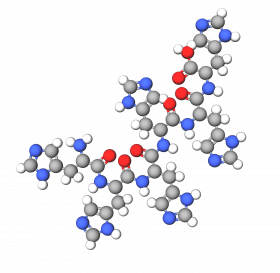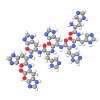Hexapeptide‑40 is a polyhistidine peptide composed of six histidine units (His‑His‑His‑His‑His‑His), also known as Hexa-His. In biotechnology, this same sequence is widely known as the His6‑tag, a standard affinity tag used to purify recombinant proteins.
Thanks to the imidazyl group in histidine, the His6-tag binds strongly to divalent transition metals such as Ni2+, Co2+, Zn2+, or Cu2+. That property is used in immobilized metal affinity chromatography (IMAC) for the purification of peptides and proteins.
While a free Hexapeptide‑40 has a strong affinity for bivalent metal ions, it has no practical use in personal care products as a chelating agent or with other function. When fused to a recombinant protein, its sequence enables efficient purification from complex lysates.
By inserting the His6‑tag coding sequence at the N- or C-terminus of a necessary gene, biotechnologists can facilitate peptide purification from host cell lysates. This approach can reduce the cost and complexity of producing recombinant peptides in hosts such as E. coli or Nicotiana benthamiana, including cosmetic actives like growth factors.For example, a plant‑derived analog of the popular sh‑Oligopeptide‑1 (EGF), known as Nicotiana Benthamiana Hexapeptide‑40 sh‑Oligopeptide‑1, can be produced in gene-modified N. benthamiana. This method offers a more scalable and potentially cheaper alternative to traditional microbial production.
However, not every biologically active peptide is compatible with a His‑tag. In many cases, the tag must be removed after purification to preserve biological activity and meet regulatory standards. Still, plant‑derived analogs of many recombinant peptides can retain comparable biological effects while benefiting from more convenient production methods.
F.A.Q.
Is there a product with Hexapeptide-40?
No.
This article aims to explain the role of the His6-tag in the purification of peptides synthesized by living organisms. It is a biotechnological tag, not a primary cosmetic active.
Later, we found that many mass-generated websites confidently mislabel Hexapeptide‑40 as a "skin‑conditioning agent", claim anti‑inflammatory and soothing properties, or that it is often used in skincare formulations. None of this is true. If you see such claims, you've found a textbook example of generative fluff.
It isn't a skincare ingredient; it is a perfect litmus test for generative content.

